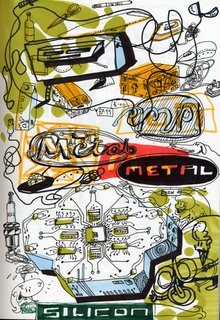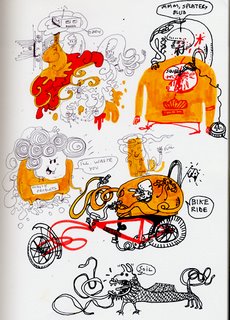proper post number 1, an image i doodled (yea)
Juxtapoz Art & Culture Magazine (pronounced Jucks-tah-pose) is a
magazine created in 1994 by a group of artists and collectors including
Robert Williams[1], Fausto Vitello, C.R. Stecyk III (aka: Craig Stecyk), and Greg Escalante, to both help define and celebrate urban alternative and underground contemporary art. It was edited from 1996 to 2006 by Jamie O'Shea.
Juxtapoz is published by
High Speed Productions, the same company that publishes
Thrasher Skateboard magazine in
San Francisco, California.
Unique in the field of publishing,
Juxtapoz emerged at a critical moment during the genesis of the late-20th Centuy underground art movement with the mission of connecting seminal modern genres like psychedelic and hot rod art, graffiti, street art, and illustration, to the context of broader more historically recognized genres of art like Pop, assemblage, old master painting, and conceptual art. Although based in San Francisco,
Juxtapoz was founded upon the belief in the virtues of Southern California Pop Culture and the freedom from the conventions of the "established" New York art world that governed the industry. Ferus Gallery, run by Walter Hopps and Irving Blum in the 1950s and 1960s was the ultimate cultural touchstone for the magazine.
Juxtapoz originally reflected Williams' own
Kustom Kulture sensibility—a combination of California
"Big Daddy" Ed Roth-style
pop surrealism (identified by some as synonymous with low brow art and others as its own genre, as detailed in low brow art entry)
[2] and the serious figurative craftsmanship that is more likely to be found among
illustrators than
fine artists today.
Despite the graphic origins of the magazine,
Juxtapoz evolved greatly in the early 2000s to embrace and chronicle many other nascent styles and sub-genres of underground art, becoming the singular voice for the movement as a whole in the process. Today,
Juxtapoz is widely credited with being the unifying force that drew together the various satellite art movements like street art and Pop Surrealism, into one coherent movement of "alternative art" that evolved so rapidly during the late '90s and early '00s.
One of the most notable contemporary artists to rise to prominence in the pages of
Juxtapoz is street artist and graphic designer
Shepard Fairey whose "
Obey Giant" street art campaign revolutionized the movement. In 2008, after a string of sold-out international fine art shows, Fairey gained international renown when he created the signature campaign artwork for
Barack Obama's presidential campaign. More than perhaps any other, this single event signified exactly how far the underground art world had come in such a short time. Fairey has since faced a legal battle over the original copyright of the image from which the piece was created.
Many renowned young artists received their first serious recognition in
Juxtapoz, including
KAWS,
Mark Ryden,
Barry McGee,
Todd Schorr,
Camille Rose Garcia,
Tim Biskup, and
Tom Sachs, among others. One of the most marked virtues of
Juxtapoz has always been its egalitarian curating mandate that no degree of fame or success in the art world was required for consideration in the magazine's pages. Good work and great imagery was any artist's ticket to the show.
Currently,
Juxtapoz has the largest circulation of any art magazine in the United States.
[citation needed] In addition to printed subscriptions which offer alternative cover images to the newsstand version, Juxtapoz is also available as an on-line digital subscription.

 hi not much to say, but please have a look at this sketchpad page from yesterdays sketching session. the image is a bit small here so please click on it to see an enlarged version. feel free to comment or ask any questions,
hi not much to say, but please have a look at this sketchpad page from yesterdays sketching session. the image is a bit small here so please click on it to see an enlarged version. feel free to comment or ask any questions,


